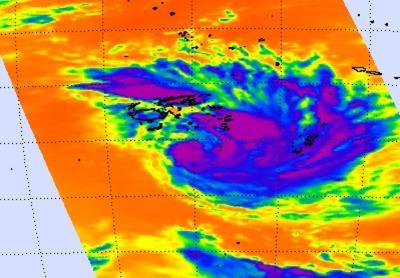It's not unusual for NASA satellites to attend the birth of tropical cyclones, and NASA's Aqua satellite was there when Tropical Cyclone Bune was born early today in the South Pacific Ocean.
Bune developed from System 99P, a low pressure area that was about 200 miles southeast of Suva, Fiji yesterday, March 23. The low intensified into tropical depression 19P and today strengthened further into Tropical Storm Bune.
A Tropical Cyclone Alert is in force for Lau, Lomaiviti and nearby smaller islands. A strong wind warning is also in force for the Lau group, Lomaiviti group and nearby smaller islands.
NASA's Aqua satellite captured an infrared image of Bune that showed strongest convection (rapidly rising air that forms the thunderstorms that make up a tropical cyclone) was occurring on the north side of the center of circulation. That's where the cloud top temperatures were the coldest, and the thunderstorms were the highest, and strongest. The low-level circulation center also appears to be consolidating (strengthening) on infrared imagery.

Aqua's Atmospheric Infrared Sounder (AIRS) instrument captured Bune's (purple and blue) high thunderstorm cloud temperatures at 1:35 UTC on March 24, 2011. The strongest thunderstorms were north of the center of circulation (purple).
(Photo Credit: NASA JPL, Ed Olsen)
Infrared imagery measures temperatures and not only can it see cold, high cloud tops in tropical cyclones, but also the warm ocean waters that power the cyclones (if the sea surface temperatures are over 80F (26.6 C)). Cold cloud top temperatures provide clues about the power of the thunderstorms in a tropical cyclone. The colder the clouds are, the higher they are, and the more powerful the thunderstorms are that make up the cyclone. Bune's cloud temperatures were colder than - 63F (-52C), indicating very cold, high, strong thunderstorms within.
Today, March 25 at 0900 UTC (5 a.m. EDT), Tropical Storm Bune's maximum sustained winds were up to 45 knots (52 mph/83 kmh) with higher gusts. It was moving away from Fiji and is now located about 260 miles (418 km) southeast of Suva, Fiji near 21.1 South latitude and 179.8 West longitude. Tropical-Storm force winds extended outward from the center up to 50 miles (80 km). It was creating 15 foot (4.5 meter) high waves.
Forecasters at the Joint Typhoon Warning Center are forecasting intensification as the storm moves away from Fiji. It is expected to become extra-tropical far to the north of New Zealand.
Source: NASA/Goddard Space Flight Center